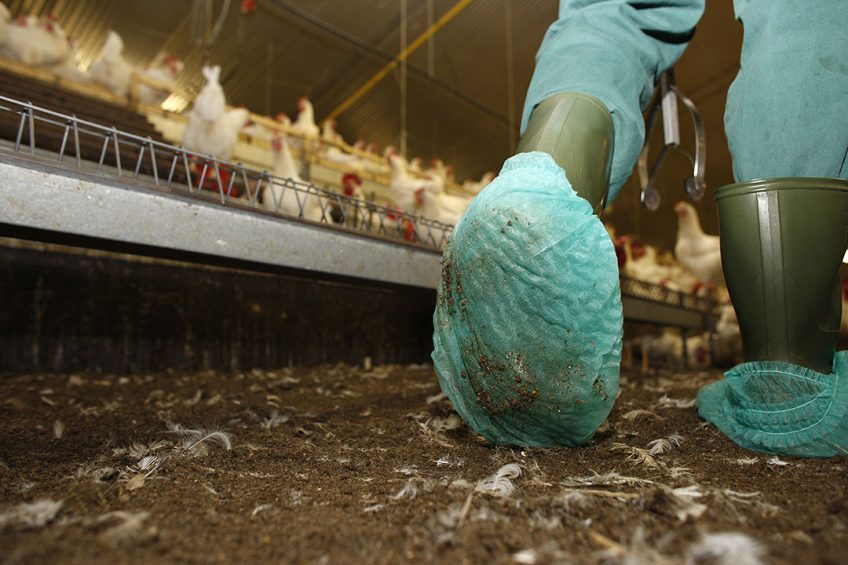Exploring ways to reduce salmonella in poultry

Researchers from 2 US universities have joined forces with the US Department of Agriculture (USDA) to explore alternatives to antibiotics for reducing salmonella in poultry.
Scientists from the University of Georgia and Colorado State University are working with staff at USDA to develop novel techniques , focusing on preventing infection and predicting risk in antibiotic-free production. Each year, Salmonella infects around 1.2m people and results in economic loses of between $ 2.3bn and $ 11.3bn in the United States and its prevalence has remained unchanged for many years.
The research, led by USDA’s Dr Adelumola Oladeinde is concentrating on Salmonella Heidelberg – one of the main strains that causes food-borne outbreaks. The strain is particularly hard to get rid of after colonising broiler farms. “Infections caused by Salmonella Heidelberg are also more invasive than other strains, and Salmonella Heidelberg associated with poultry tends to carry antibiotics resistance and virulence genes. Therefore, it represents a model organism for testing the mechanisms that we have been developing,” he said. The team is focusing its efforts in 2 key areas – examining how the type of poultry litter in broiler houses can prevent infection and development of antibiotic resistance, and devising a flock health monitoring system that can help us to predict infection risk sooner.
Poultry litter: fresh vs recycled
It is fairly common practice in the US for producers to recycle poultry litter over multiple flocks for a year or longer. Dr Oladeinde and his team studied the impact of using fresh or recycled bedding material on the incidence of Salmonella within the flock and its impact on the development of antibiotics resistance – even in the absence of antibiotic use. The team inoculated fresh and reused broiler litter in the lab with different strains of Salmonella and monitored it for 14-21 days. They also carried out experiments with live birds – rearing chickens carrying Salmonella Heidelberg on either fresh or recycled litter. They found that the microbiome present in the reused litter negatively correlated with the populations of antibiotic-resistant Salmonella Heidelberg in the chickens’ guts, compared with broilers raised on fresh litter: “This suggests that reused litter promotes an unfavourable microbiome for Salmonella carrying antibiotic resistance,” he said.
 Reducing the risk of salmonella re-contamination in feed
Reducing the risk of salmonella re-contamination in feed
Deploying risk mitigation strategies across the feed-to-food production chain can help assure safe animal feed and poultry production. However, certain processes can circumvent routine cleaning and hygiene practices.
Predicting Salmonella infection in poultry
The team has also been investigating new ways to predict the Salmonella risk within a flock. Wider studies have shown that some beneficial bacteria identified by the team in the microbiomes of birds raised on reused litter, including Bifidobacterium, can alleviate anxiety and depressive-like symptoms in mice and humans, indicating that the gut microbiome can have a positive impact on the brain. It has led them to embark on the development of an automated vision-based Salmonella Predictor, which they hope should be able to identify and locate individual birds with Salmonella infections within the first 2 weeks of life.
 Salmonella most common cause of foodborne outbreaks in EU
Salmonella most common cause of foodborne outbreaks in EU
Almost a third of foodborne outbreaks were caused by salmonella in the European Union in 2018, new data has revealed.
Social cues of Salmonella-free broiler chickens
The Predictor will use advanced imaging techniques to collect information on poultry health and social cues associated with Salmonella infection, including behaviour traits, bird weight and body temperature. Microbiology and molecular genetics will also be used to determine Salmonella prevalence, virulence and antimicrobial resistance status. Currently in early stage of development, the team are trying to train the system to identify social cues of Salmonella-free broiler chickens raised without antibiotics. Subsequent stages will include testing the Predictor on images of broiler chicks that have been inoculated with Salmonella Heidelberg strains and optimising the Predictor for a verification test in a commercial broiler house. “If our proposed early prediction tool is successfully developed and adopted by just 5% of US chicken producers, it could reduce the number of Salmonella-carrying chickens at slaughter by 90m annually. This will significantly improve food safety and reduce the need to recall chickens because of Salmonella contamination,” he added.








